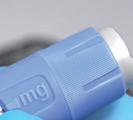Medicine Optimisation
Anaesthetic Gases
The most damaging anaesthetic inhalation agent is desflurane, which has 20 times the global warming potential of sevoflurane.6 Operating departments have demonstrated substantial reductions in carbon emissions from volatile anaesthetics by applying desflurane-sparing practices; for example, switching to sevoflurane, using less inhalational anaesthetic agents through low flow machines, and alternative anaesthesia methods such as total intravenous anaesthesia.6
1 hour of surgery using sevoflurane is equivalent to driving 5-10 kms
1 hour of surgery using desflurane is equivalent to driving 200-400 kms
Medicines Stewardship and Quality Use of Medicines
Pharmacists and prescribers have an important role in medicine optimisation, where increased medicine use is directly linked to increased environmental impact.7 Strategies include engaging patients in their healthcare decisions to improve adherence, counselling patients on safe disposal of medicines, minimising overprescribing, and reducing waste through interventions such as ‘intravenous to oral antibiotic switch’.
Respiratory Inhalers
Respiratory medicine is one such space where optimising patient care through education and inhaler choice can reduce the carbon impact significantly.8,9 Following recommended respiratory management guidelines and reviewing inhaler technique can help to improve patient symptoms and quality of life, and good disease control has the benefit of minimising carbon impact from reducing excessive inhaler use.8 Although the clinical condition of the patient takes priority when determining inhaler choice, the environmental impact of inhalers is increasingly being recognised in treatment strategies.
Pressurised Metered Dose Inhalers (pMDIs) contain hydrofluoroalkanes (HFAs) as propellants that are potent greenhouse gases; 1300-3350 times more potent than CO2 8 The most frequently used pMDIs are short acting beta agonists such as salbutamol. However, not all pMDIs have an equal impact on carbon emissions. Some brands use HFAs with a greater environmental impact than others (Figure 1).9 Choosing the pMDI device with lower carbon impact should be considered where clinically appropriate. Dry Powder Inhalers (DPIs) do not use HFA propellants, and have a much smaller carbon footprint compared with pMDIs.9 However, pMDIs enhance medication delivery and efficacy through reduced inspiratory effort when used via a spacer.9 Where clinically appropriate, selecting a DPI device over a pMDI can reduce carbon impact.
Trelegy Ellipta
Asmol/Ventolin/Zempreon
Breo Ellipta Atrovent
Symbicort Turbuhaler
Spiriva Respimat*
Symbicort Rapihaler
Flutiform
Seretide/Pavtide
Breztri Aerosphere or Trimbow
Ultibro or Onbrez Alvesco



 LOWEST carbon impact
LOWER carbon impact pMDIs
HIGHER carbon impact pMDIs
Dry Powder Inhaler / Soft Mist Inhaler*
Pressurised Metered Dose Inhalers (HFA 134a propellant)
Pressurised Metered Dose Inhalers (HFA 227e propellant)
LOWEST carbon impact
LOWER carbon impact pMDIs
HIGHER carbon impact pMDIs
Dry Powder Inhaler / Soft Mist Inhaler*
Pressurised Metered Dose Inhalers (HFA 134a propellant)
Pressurised Metered Dose Inhalers (HFA 227e propellant)
you have any
content
from error or omission.
Reference List
Figure 1. Examples of common inhaler brands and their carbon impact9
If
queries regarding Circuit
and authors please contact your pharmacy
manager.
Every effort has been made to ensure this newsletter is free
epicpharmacy.com.au Edition
Ref: Propellants as listed in Approved Australian Product Information, accessed online via MIMs, January 2024. Carbon impact of propellants from Fulford et al.
200-400km 0 0-200km
Environmentally friendly healthcare requires investment and proactive decision making to reduce waste. All healthcare workers can have a role in minimising health’s carbon footprint and helping Australia reach our Net Zero 2050 climate goals.
An update on stock availability of Glucagon-like peptide-1 agonists
Samantha Caruso, Epic Pharmacy Brisbane Private
Glucagon-like peptide-1 (GLP-1) agonists including semaglutide and dulaglutide have been experiencing supply shortages since the beginning of 2022. The shortages are attributed to off-label prescribing for obesity management. Demand for semaglutide was exacerbated by televised and social media. Patients were transferred to dulaglutide as an alternative medication resulting in an unprecedented demand. Despite these shortages occurring for almost two years, supply constraints still exist on these products.
Type 2 Diabetes Mellitus
Semaglutide (Ozempic) is approved for the treatment of adults with insufficiently controlled Type 2 Diabetes Mellitus (T2DM) as monotherapy when metformin is not tolerated/contraindicated or in addition to other medicinal products for the treatment of T2DM. The Therapeutic Goods Administration (TGA) has advised that supply of semaglutide will continue to be limited throughout 2024.1 Semaglutide should only be prescribed for the TGA approved indication and prescribers are advised not to initiate new patients on semaglutide unless there are no suitable alternatives or there is a compelling clinical reason to prescribe.1 Prescribers should consider whether those already prescribed semaglutide can be changed to alternative therapy which will result in less disruptions to treatment but also allow supplies to be conserved for patients stabilised on semaglutide with no alternative treatment options.
Dulaglutide (Trulicity) is a GLP-1 agonist approved as adjunct treatment for T2DM. The current shortage of dulaglutide is expected to continue until the end of 2024.2




























The TGA have provided temporary approval to the supply of overseasregistered products under section 19A of the Therapeutic Goods Act 1989. Section 19A imports may trade under the same brand name, however the packaging label and instructions may be written in a non-English language. Currently, these section 19A products are not listed on the Pharmaceutical Benefits Scheme (PBS) which may also be a barrier in switching a patient to these alternatives. Prescribers should refer to the TGA website for further information on current imports available. The uptake of these products is limited due to intermittent supply from distributors and the price to the patient.
Recently, the TGA have released a safety alert about the emerging trend for semaglutide-like compounded products. The safety alert states “compounded semaglutide-like products are ‘unapproved’ therapeutic goods and have not been evaluated for safety, quality and efficacy”.3 The safety alert reinforces that the compounding of medicine should be reserved for exceptional clinical circumstances where all suitable alternative treatments using
approved therapeutic goods, which are those included on the Australian Register of Therapeutic Goods (ARTG), are unavailable, have failed, or are deemed unsuitable for the patient.3 Furthermore, the US Food and Drug Administration (FDA) recently released a statement warning consumers of safety risks associated with compounded semaglutide-like products following an increase in adverse events being reported.3 Therefore, compounded semaglutide-like products are not an advisable alternative for patients. Suitable medication treatment options approved by the TGA are summarised in Table 1.
Tirzepatide (Mounjaro) is a long-acting dual glucose-dependent insulinotropic polypeptide (GIP) and GLP-1 agonist. Unfortunately, only a few months after launch in September 2023, there was a manufacturing shortage and currently supply is not expected to return until September 2024. Liraglutide (Victoza) is another GLP-1 agonist, however it requires daily injections. Neither liraglutide nor tirzepatide are PBS listed so the cost of these medications may be a deterrent.
Weight management
A semaglutide product (Wegovy) is TGA approved for weight management. However, stock is yet to reach the Australian market and no time frame has been provided by the manufacturer. A once daily liraglutide product (Saxenda) is also currently TGA indicated for weight management but not PBS listed.
where Victoza is indicated to improve glycaemic control, Victoza is indicated to reduce the risk of cardiovascular events in those at high cardiovascular risk, as an adjunct to standard of care therapy.
Daily subcutaneous injection
Semaglutide
Liraglutide
Once weekly subcutaneous injection
Indication PBS Listed Administration Semaglutide (Ozempic) Treatment of adults with insufficiently controlled Type 2 Diabetes Mellitus (T2DM) as monotherapy when metformin is not tolerated/contraindicated or in addition to other medicinal products Yes Once weekly subcutaneous injection Dulaglutide (Trulicity) Adjunct treatment for adult patients with T2DM Yes Once weekly subcutaneous injection Tirzepatide (Mounjaro) Treatment of adults with insufficiently controlled Type 2 Diabetes Mellitus (T2DM) as monotherapy when metformin is not tolerated/contraindicated or in addition to other medicinal products No Once weekly subcutaneous injection Liraglutide (Victoza) Treatment of adults with insufficiently controlled Type 2 Diabetes Mellitus (T2DM) as monotherapy when metformin is not tolerated/contraindicated or in addition to other medicinal products. Prevention of cardiovascular events: In patients
No
No
(Wejovy) Obesity management and supporting weight loss
(Saxenda) Obesity management and supporting weight loss No Daily subcutaneous injection
Table 1: Comparison of injectable medications for TD2M and weight loss (information current as of Feb 2024 for TGA approved products)
Research from our staff In 2023 our pharmacy staff conducted a number of research projects that were presented at the annual Society of Hospital Pharmacists (SHPA) and the Clinical Oncology Society of Australia (COSA) conferences. We have included one of these projects below to give you some understanding of our innovations. Please scan the QR to read more!




A comparison of carboplatin dosing using the CockcroftGault equation versus BSA-adjusted eGFRCKD-EPI equation
Linda Nguyen1, Ian Kei Yee2, Neil Kim Chiu Lam1
1. Icon Wesley Pharmacy, Icon Cancer Centre, Brisbane, QLD, Australia
2. School of Pharmacy, University of Queensland, Brisbane, QLD, Australia
Background
Carboplatin is a chemotherapy drug used to treat a variety of cancers. Its dosing is based on the Calvert Formula and requires the patient’s glomerular filtration rate (GFR) in its calculation. Historically, the Cockcroft-Gault (CG) equation was used to determine estimated GFR (eGFR), by calculating creatinine clearance. However, with the recently introduced International Consensus Guideline for Anticancer Drug Dosing in Kidney Dysfunction (ADDIKD), the Chronic Kidney Dysfunction-Epidemiology Collaboration 2009 equation (eGFRCKD-EPI) is recommended to replace the Cockcroft-Gault equation in determining eGFR due to increased precision and accuracy.1
Aim
This study aimed to compare the carboplatin dose variation between the Cockcroft-Gault and body surface area (BSA) adjusted eGFRCKD-EPI equations.
Method
• Retrospective audit of initial carboplatin doses (n=127) administered between 1st January and 31st December 2022 to adult cancer patients at a day oncology clinic
• Patient characteristics collected include age, sex, weight, height, serum creatinine and target area under the curve (AUC)
• Carboplatin doses were calculated using the Calvert formula
• GFR was calculated using the CG and BSA-adjusted eGFRCKD-EPI equations (refer to Table 1 and 2). Note that creatinine clearance (CrCl) was capped at 125mL/min when calculating the carboplatin dose using the CG equation
• Statistical analysis included:
- Paired t-test – to compare the mean carboplatin dose calculated using the CG and BSA-adjusted eGFRCKD-EPI equations
- Pearson correlation coefficient – to investigate the relationship between patient characteristics and percentage dose variation.
Results
• 70.9% of doses (90/127) had ≤10% dose variation between the CG and BSA-adjusted eGFRCKD-EPI method (Figure 1)
• 23.6% of doses (30/127) had a >10% to ≤20% dose variation (Figure 1)
• Mean carboplatin dose between the two methods did not reach statistical significance (p=0.06)
• Weak correlation between weight and percentage dose variation was observed (r=-0.39)(Figure 2)
• Weak correlation between body mass index (BMI) and percentage dose variation was observed (r=-0.52)(Figure 3)
Individual Patient
Equation
Calvert Formula Carboplatin dose = (GFR + 25) x target AUC
Cockcroft-Gault (CG) Equation Creatinine Clearance (CrCl) = [(140-age) x weight (kg)]/(0.814 x SCr (micromol/L)) (x 0.85 for females)
BSA-adjusted eGFRCKD-EPI
Equation BSA-adjusted eGFRCKD-EPI (mL/min) = [eGFRCKD-EPI(mL/min/1.73 m2) x BSA (m2)]/1.73
Sex Serum creatinine (SCr) eGFRCKD-EPI equation
Female ≤ 62 micromol/L eGFRCKD-EPI (mL/min/1.73m2) = 144 x (SCr (micromol/L) x 0.0113/0.7)-0.329 x (0.993)age
> 62 micromol/L eGFRCKD-EPI (mL/min/1.73m2) = 144 x (SCr (micromol/L) x 0.0113/0.7)-1.209 x (0.993)age
Male ≤ 80 micromol/L eGFRCKD-EPI (mL/min/1.73m2) = 141 x (SCr (micromol/L) x 0.0113/0.9)-0.411 x (0.993)age
> 80 micromol/L eGFRCKD-EPI (mL/min/1.73m2) = 141 x (SCr (micromol/L) x 0.0113/0.9)-1.209 x (0.993)age
Discussion
In this study, the majority of doses calculated using the BSA-adjusted eGFRCKD-EPI equation were within 20% compared to the CG equation. 5.5% of doses (n=7) had a >20% dose variation. This result shows some similarity with another study that investigated carboplatin dose calculations including the BSA-adjusted eGFRCKD-EPI equation.2 However, a lack of information from the literature regarding an acceptable percentage dose difference makes the interpretation of results difficult.
It was also observed that extremes in body weight and BMI had a larger percentage dose variation, although these were weak correlations.
Study limitations include the small sample size and single centre. Additionally, the clinical significance on patient outcomes were not assessed, but would be an area of interest for future studies.
Conclusion
With the implementation of the BSA-adjusted eGFRCKD-EPI equation in practice, this study will provide insight and reassurance to clinicians regarding the dose variation between the two methods. However, further study is required to determine its clinical significance.
AU ICC 112921 2402 References 1. Sandhu G, Adattini J, Armstrong Gordon E, O’Neill N. On behalf of the ADDIKD Guideline Working Group. International consensus guideline on anticancer drug dosing in kidney dysfunction. 2022. eviQ, Cancer Institute NSW. St Leonards, Australia. 2. Akgül S, Chan B, Manders P. Carboplatin dose calculations for patients with lung cancer: significant dose differences found depending on dosing equation choice. BMC Cancer. 2022 Jul 30;22(1):829.
Figure 1: Waterfall plot comparing the percentage dose variation between Cockcroft–Gault and BSA-adjusted eGFRCKD-EPI equations for individual patients
Figure 2: Scatter plot comparing percentage dose variation between Cockcroft–Gault and BSA-adjusted eGFRCKD-EPI equations versus weight
40% 0% 20% -20% 30% -10% 10% -30% Dose Variation
Figure 3: Scatter plot comparing percentage dose variation between Cockcroft–Gault and BSA-adjusted eGFRCKD-EPI equations versus body mass index (BMI)
Table 1: Calvert Formula, Cockcroft-Gault and BSA-adjusted eGFRCKD-EPI equations1
Table 2: eGFRCKD-EPI equations1
Dose Variation Weight (kg) 0% 20% 30% 10% 40% -30% -20% -10% 0 20 40 60 80 100 120 140 Dose Variation Body Mass Index (kg/m2) 0% 20% 10% -30% -20% -10% 30% 40% 0.00 10.00 5.00 15.00 20.00 30.00 45.00 25.00 40.00 35.00 50.00
AU GRP_112924_2402























 LOWEST carbon impact
LOWER carbon impact pMDIs
HIGHER carbon impact pMDIs
Dry Powder Inhaler / Soft Mist Inhaler*
Pressurised Metered Dose Inhalers (HFA 134a propellant)
Pressurised Metered Dose Inhalers (HFA 227e propellant)
LOWEST carbon impact
LOWER carbon impact pMDIs
HIGHER carbon impact pMDIs
Dry Powder Inhaler / Soft Mist Inhaler*
Pressurised Metered Dose Inhalers (HFA 134a propellant)
Pressurised Metered Dose Inhalers (HFA 227e propellant)































